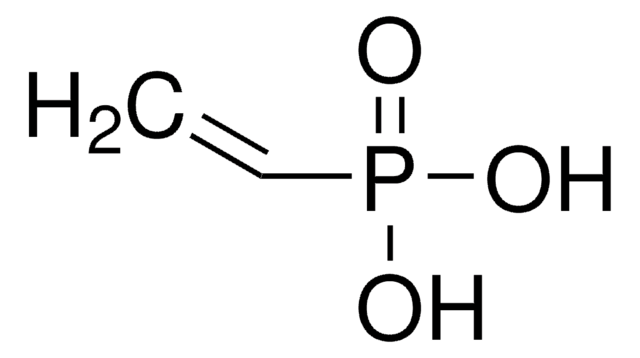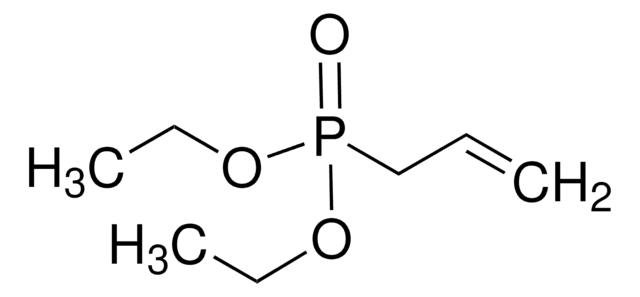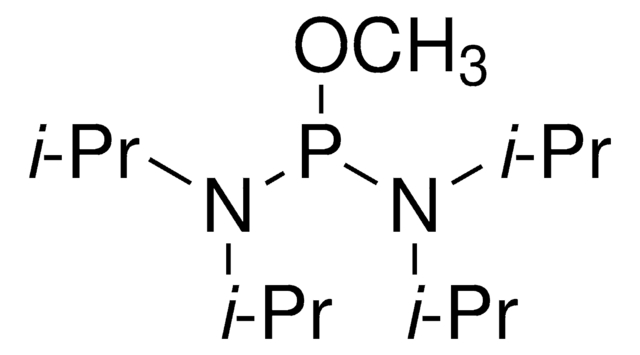496758
Bis[2-(methacryloyloxy)ethyl] phosphate
Sinónimos:
2-Hydroxyethyl methacrylate phosphate, Bis(2-methacryloyloxyethyl) acid phosphate, Bis(2-methacryloyloxyethyl) hydrogen phosphate, Bis(methacryloyloxyethyl) hydrogen phosphate, Bis(methacryloyloxyethyl) phosphate, Bis[2-(methacryloyloxy)ethyl] phosphate, Di(2-methacryloyloxyethyl) phosphate, Di-2-methacryloyloxyethyl acid phosphate
About This Item
Productos recomendados
índice de refracción
n20/D 1.47 (lit.)
bp
221 °C (lit.)
densidad
1.28 g/mL at 25 °C (lit.)
temp. de almacenamiento
2-8°C
cadena SMILES
CC(=C)C(=O)OCCOP(O)(=O)OCCOC(=O)C(C)=C
InChI
1S/C12H19O8P/c1-9(2)11(13)17-5-7-19-21(15,16)20-8-6-18-12(14)10(3)4/h1,3,5-8H2,2,4H3,(H,15,16)
Clave InChI
NXBXJOWBDCQIHF-UHFFFAOYSA-N
Categorías relacionadas
Descripción general
Aplicación
- As a bifunctional crosslinker to synthesize superabsorbent polymers (SAPs) via free radical polymerization. These SAPs can be used for agricultural applications.
- To prepare self-etching primer formulations for enamel and dentine. Primers with BMEP exhibit good wetting, etching, and penetration in both dentine and enamel.
- As a precursor to synthesize fire retardant nanocomposites via suspension polymerization.
Características y beneficios
- Presence of dimethacrylate groups enables cross-linking and improves copolymerization.
- Hydrophilicity and short carbon chains can enhance wetting.
Palabra de señalización
Warning
Frases de peligro
Consejos de prudencia
Clasificaciones de peligro
Eye Irrit. 2 - Skin Irrit. 2 - STOT SE 3
Órganos de actuación
Respiratory system
Código de clase de almacenamiento
10 - Combustible liquids
Clase de riesgo para el agua (WGK)
WGK 3
Punto de inflamabilidad (°F)
Not applicable
Punto de inflamabilidad (°C)
Not applicable
Equipo de protección personal
Eyeshields, Gloves, type ABEK (EN14387) respirator filter
Certificados de análisis (COA)
Busque Certificados de análisis (COA) introduciendo el número de lote del producto. Los números de lote se encuentran en la etiqueta del producto después de las palabras «Lot» o «Batch»
¿Ya tiene este producto?
Encuentre la documentación para los productos que ha comprado recientemente en la Biblioteca de documentos.
Los clientes también vieron
Nuestro equipo de científicos tiene experiencia en todas las áreas de investigación: Ciencias de la vida, Ciencia de los materiales, Síntesis química, Cromatografía, Analítica y muchas otras.
Póngase en contacto con el Servicio técnico

![[2-(Methacryloyloxy)ethyl]dimethyl-(3-sulfopropyl)ammonium hydroxide 95%](/deepweb/assets/sigmaaldrich/product/structures/217/219/73c91e1c-0ee4-4b3d-bead-a6dc3d09d1da/640/73c91e1c-0ee4-4b3d-bead-a6dc3d09d1da.png)











